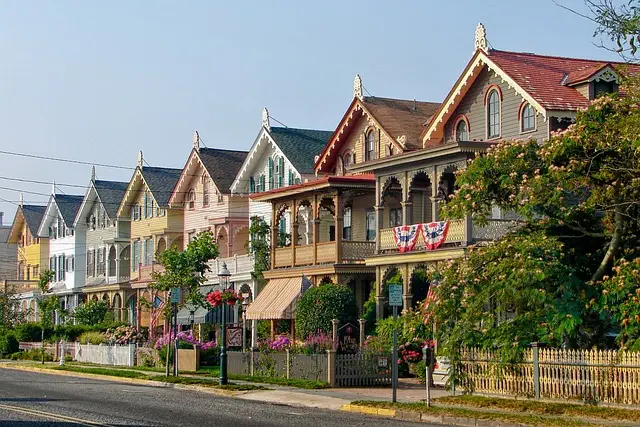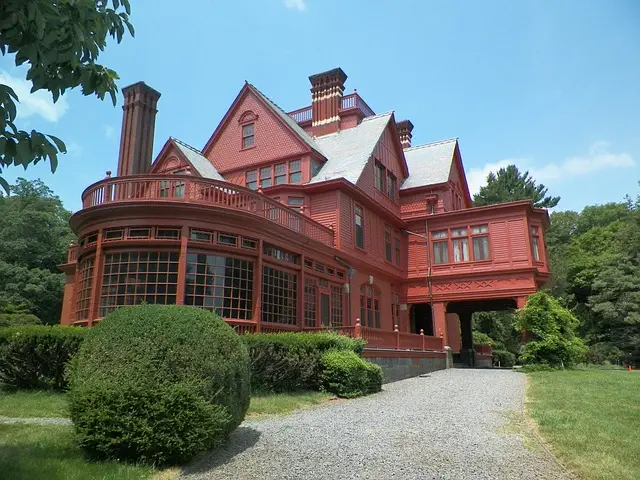The Albany Street Bridge in New Brunswick, Middlesex County, New Jersey, is a historic landmark completed in 1890 that serves as a key transportation link connecting the downtown with adjacent communities across the Raritan River. It showcases the region's engineering legacy and historical importance, having been meticulously preserved through renovations and included on the National Register of Historic Places. This bridge is not just a vital component of local transportation networks but also a symbol of Middlesex County's evolution in transportation systems over time. It invites exploration of the county's cultural offerings, rich heritage, and economic landscapes, ensuring connectivity while linking the area's past with its present. The bridge stands as a narrative of Middlesex County's development, exemplifying the county's dedication to both practical infrastructure and aesthetic appeal. It is a source of community pride, attracting tourists, and securing its role as a defining feature of New Brunswick's identity within Middlesex County, emphasizing its commitment to progress and resilience. The bridge has adapted over time to reflect Middlesex County's shift towards sustainable transportation, becoming an integral part of the county's network of paths and bike lanes, and underscoring a broader commitment to eco-friendly practices in urban planning within New Jersey.
welcome to an exploration of the Albany Street Bridge, a historic and integral part of New Brunswick, NJ. This architectural marvel not only stands as a testament to human ingenuity but also holds significant cultural weight within Middlesex County, New Jersey. Its design, a fusion of aesthetics and functionality, has shaped the urban landscape of New Brunswick, influencing local transportation systems and community dynamics. As we delve into its history, engineering marvels, and future plans, join us in celebrating this iconic structure’s contributions to Middlesex County’s heritage and its role in sustainable transportation solutions.
- Albany Street Bridge: A Historical Icon of New Brunswick, NJ
- Design and Architecture: The Engineering Marvel Behind Albany Street Bridge
- Cultural Significance: Albany Street Bridge's Role in Middlesex County's Heritage
- Community Impact: How Albany Street Bridge Shapes New Brunswick's Urban Landscape
- Sustainable Transportation: The Evolution of Travel Across Albany Street Bridge
- Future Plans: Envisioning the Next Chapter for Albany Street Bridge in Middlesex County, NJ
Albany Street Bridge: A Historical Icon of New Brunswick, NJ

The Albany Street Bridge stands as a testament to the engineering prowess and historical significance of New Brunswick, NJ, within Middlesex County, New Jersey. This iconic structure, first constructed in 1890, has undergone various renovations while retaining its original architectural charm. It is a vital component of the city’s transportation infrastructure, connecting the vibrant downtown area with the neighboring communities across the Raritan River. The bridge’s rich history is interwoven with the county’s evolution, reflecting the growth and changes in transportation and urban development over the decades. Its distinctive design, combining functionality with aesthetics, has earned it a place on the National Register of Historic Places, highlighting its importance as a historical landmark. Today, it remains an active thoroughfare, offering residents and visitors alike a route to explore the rich tapestry of Middlesex County’s culture, heritage, and economic activities. The Albany Street Bridge not only serves as a conduit for movement but also as a connector of stories, linking the past with the present in this corner of New Jersey.
Design and Architecture: The Engineering Marvel Behind Albany Street Bridge

The Albany Street Bridge, a key component of New Brunswick’s urban landscape in Middlesex County, New Jersey, stands as a remarkable feat of engineering and architectural design. This iconic bridge, which spans the Raritan River, not only facilitates transportation but also serves as a visual symbol of the city’s progress and innovation. Its design incorporates both functional and aesthetic elements, creating a harmonious blend that enhances the city’s skyline. The architecture of the Albany Street Bridge is characterized by its elegant trusses and cables, which are not only structurally sound but also visually striking, reflecting the advancements in bridge engineering during its construction era. The bridge’s design is a testament to the engineering prowess that Middlesex County, New Jersey, has fostered over the years, showcasing the county’s commitment to infrastructure and public spaces that are both functional and aesthetically pleasing. The Albany Street Bridge’s architectural integrity and engineering sophistication have made it a point of pride for residents and a must-see attraction for visitors, further cementing its place as an integral part of New Brunswick’s identity.
Cultural Significance: Albany Street Bridge's Role in Middlesex County's Heritage

The Albany Street Bridge in New Brunswick, NJ, is a prominent architectural and engineering landmark that has played an integral role in Middlesex County’s heritage. This iconic bridge, which spans the Raritan River, is not merely a passageway but a testament to the county’s rich history and cultural significance. Over the years, it has witnessed the ebb and flow of transportation advancements, reflecting the evolution of Middlesex County from its agricultural roots to a bustling hub of innovation and education. The bridge’s design, originally completed in 1890 with a later rehabilitation in the 1920s, showcases the architectural styles and engineering prowess that have defined New Jersey’s infrastructure throughout the centuries. It stands as a visual anchor to the county’s past, connecting the vibrant city of New Brunswick with neighboring communities like Highland Park and East Brunswick, facilitating cultural exchange and commerce that has been essential to Middlesex County’s development. The Albany Street Bridge is a tangible link to the area’s history, offering residents and visitors alike an opportunity to engage with the county’s legacy while navigating its modern landscape. Middlesex County, NJ, with its diverse cultural offerings and rich historical tapestry, takes pride in this enduring structure that continues to serve as a symbol of resilience and community connection.
Community Impact: How Albany Street Bridge Shapes New Brunswick's Urban Landscape

The Albany Street Bridge, a vital architectural feature spanning the Raritan River in New Brunswick, NJ, plays a pivotal role in shaping the urban landscape of this bustling municipality within Middlesex County, New Jersey. As a key transportation artery, it facilitates the daily commute for residents and workers, connecting the city’s neighborhoods with efficiency and ease. Its presence not only streamlines traffic flow but also serves as a visual anchor, integrating seamlessly with the surrounding skyline. The bridge’s design and functionality are testaments to New Brunswick’s commitment to maintaining a dynamic and accessible urban environment. It is a critical component of the city’s infrastructure, supporting its economic vitality by enabling commerce and fostering growth in both residential and commercial sectors. The bridge’s impact extends beyond mere connectivity; it is a catalyst for development, influencing real estate trends and property values in Middlesex County. Its role in the urban fabric is multifaceted, contributing to the city’s identity as a modern and forward-thinking community that values connectivity, accessibility, and economic prosperity. The bridge stands as a symbol of New Brunswick’s resilience and adaptability, embodying the spirit of progress in Middlesex County, New Jersey.
Sustainable Transportation: The Evolution of Travel Across Albany Street Bridge

The Albany Street Bridge in New Brunswick, Middlesex County, New Jersey, has stood as a testament to the area’s commitment to transportation infrastructure since its completion in 1890. Over the years, this steel arch bridge has been an integral part of the region’s sustainable transportation network, connecting the city with the surrounding areas and facilitating travel for both residents and visitors. The evolution of travel across the Albany Street Bridge reflects broader trends in sustainable transportation, showcasing a shift from fossil-fuel dependent vehicles to more eco-friendly modes. Today, the bridge serves as a crucial link in Middlesex County’s network of pedestrian and cycling paths, encouraging residents to choose active transportation options that reduce carbon emissions and promote public health. The introduction of bike lanes and the proximity to the D&R Canal Towpath have made the Albany Street Bridge a key route for those utilizing green modes of transport, reflecting a significant transformation from its initial role as a carriageway in the late 19th century. This evolution underscores Middlesex County’s dedication to sustainable transportation practices and its ongoing efforts to integrate environmentally conscious infrastructure into its urban planning. As part of this commitment, continuous improvements and updates to the bridge’s amenities ensure it remains a vital component of the region’s sustainable transportation system, connecting communities and fostering a green approach to mobility in Middlesex County, New Jersey.
Future Plans: Envisioning the Next Chapter for Albany Street Bridge in Middlesex County, NJ







